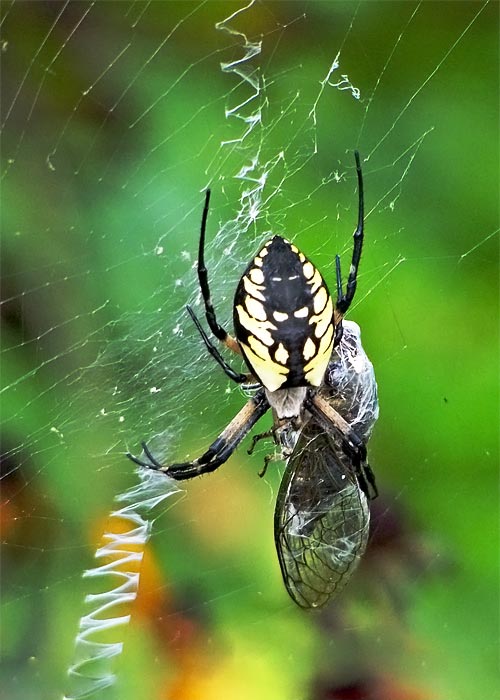Howdy, BugFans,
Also called the Black-and-yellow Argiope, this impressive gal may reach 1 1/8” in length (the male is about ¼”). Like Charlotte, she is in the Orb-weaver family.
These have really declined in number in the BugLady’s fields. A spider expert hypothesized recently that early frosts may be killing them before they reach reproductive capability.
[metaslider id=6321]
The BugLady has observed that their webs are often built in “chimneys”—cleared areas in the tall grass. It’s as though the webs exist within a glass cylinder in otherwise dense brome grass, like the spiders pull back the grasses so their webs won’t be compromised when the wind blows. The female spins the center of the web; the male adds more web around the outside and adds a thick, white, zig-zag “zipper” band to the center. It is speculated that the “zipper” makes the web more “visible” to bat radar so the web doesn’t get destroyed. There are observations of webs 10 feet across.
The female lays eggs in an egg sac that she attaches to the edge of her web. The young hatch out of their eggs in fall but spend the winter in the sac, eating yolk material and each other until it’s warm enough to emerge in spring (remember the First Law of Nature: Survival of the Fattest). The hatchlings stay together for a few days—masses of teeny spiderlings on vegetation or on the sides of buildings. The BugLady once saw a Daddy long-legs stalking the outside of a group of spiderlings (see: Law of Nature, above).
When something gets caught in the net, it is first wrapped and then disposed by biting. Cicada exoskeletons are pretty tough; this prey must have been a challenge. (The Chinese symbol for “challenge” is the same as the Chinese symbol for “opportunity.” The Bug Lady knows these things.)
The BugLady
